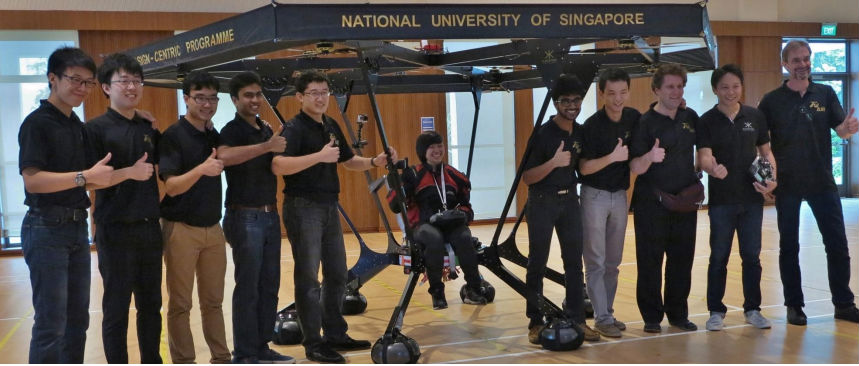Back in the 1400’s, Leonardo da Vinci had some ideas for flying machines. He designed a machine in which a pilot would lie face down on a board and power the wings with a pedal connected to a rod-and-pulley system.
What 18 students from the National University of Singapore (NUS) came up with is a bit different, but they figured out a way to turn a sci-fi dream of flying into a reality.

The students’ invention, called Snowstorm, is made up of an intricate design of motors, propellers and inflated landing gear set within a hexagonal frame. The electric-powered aircraft is capable of vertical take-off and landing that can be controlled by a single person seated inside. Snowstorm can carry a person weighing up to 154 lbs. for a flight time of about five minutes.
The students developed the personal flying machine over the course of a year and collaborated with t NUS Faculty of Engineering’s Design-Centric Program (DCP) and the University Scholars Program (USP) to make it happen.
The team doesn’t see their flying machine as a means of transportation, but more as an electric aircraft for personal recreational use in a large indoor space, to satisfy the desire to fly.
“A common trope in popular science fiction is the projection of humans flying on our own – think the “Jetsons” or even “Back to the Future.” NUS’ Snowstorm shows that a personal flying machine is a very real possibility, primarily as a means to fulfill our dreams of flying within a recreational setting,” said Dr Joerg Weigl, one of two supervisors of the project, from the Design-Centric Programme at the NUS Faculty of Engineering.
In addition to constructing the physical frame, the students also designed and implemented the craft’s electronic control and stabilization system, a pilot safety system as well as an electric energy management and supply system where the three batteries that power the craft can function independently in the event any of the batteries malfunction.
The electric flying machine is equipped with 24 motors, each driving a propeller of 76 cm diameter with 2.2 kW of power. The pilot seat is located in the center of the machine, its weight supported by six landing gear legs, the bottom of which is an inflated ball that adsorbs shock when landing. It also includes three rechargeable lithium battery sets which provide a total power of 52.8 kW.
To make sure the flyer is secured, the seat has a five-point harness. the team has also worked in a separate switch that can be controlled from the ground to end the flight and bring the machine to a landing, should the pilot lose control of the machine.
Snowstorm provides a variety of automated flight modes similar to the ones that come along with consumer Unmanned Aerial Vehicles (UAVs), including altitude hold, loiter and position modes.
“Designing and building Snowstorm was a great learning opportunity for us. The toughest part of this engineering challenge was ensuring a good thrust to weight ratio to allow the craft to lift a person into the air. At every stage of our design, we constantly had to balance and consider trade-offs between the types of materials, their characteristics and weight. In some instances, we even 3D-printed parts, such as our landing gear mount, just so we can have a customized and optimal fit,” said Shawn Sim, a third year NUS Engineering student.
The team first tested the design on a smaller 1/6 scale prototype before they constructed the real thing.
“Recent advances in motors and battery technology has made it possible for us to literally take to the skies,” said Martin Henz, associate professor at the University Scholars Programme and the School of Computing at NUS. “The NUS team will continue to fine-tune Snowstorm, working on mechanical safety measures, propeller and motor configurations, and control software and hardware to achieve the high levels of safety, simplicity and performance required for recreational use by the general public,” he added.
The NUS team will continue to make improvements to its flying machine and hopes to bring it to market in the future.


Comments are closed, but trackbacks and pingbacks are open.